There’s so much jargon around types of EV charging, sometimes you can feel like you need an engineering degree to understand it all. There can be a lot to keep track of: high voltage electricity, charging standards, vehicle compatibility, acronyms and charge speed.
I’ve had an eye on EV and the charging technology that quite literally powers them for over 15 years here at CNET. To help you understand what to expect, I’m going to break down how EV charging hardware works, what each level of EV charging means and give examples of the speed and performance you can expect when plugging in your electric car.
What is an EV charger? What’s not?
The box and cord that plug into the wall are what you’re probably thinking of as your “EV charger,” but that’s not what they are. Your EV’s charger is actually built into the vehicle’s onboard power electronics where it converts alternating current, or AC, electricity received from the grid into the direct current, DC, that can be received and stored by the EV’s battery.
The same hardware is often used to convert that DC energy back into AC to spin the wheels, incidentally, but we’re not here to talk about how electric motors work.
In fact, the charging cable and box are what’s known as EV supply equipment, or EVSE. But I’m an expert, not a pedant. I’ll be referring to EVSE as charging cables or charging stations going forward, since that’s what normal people call them.
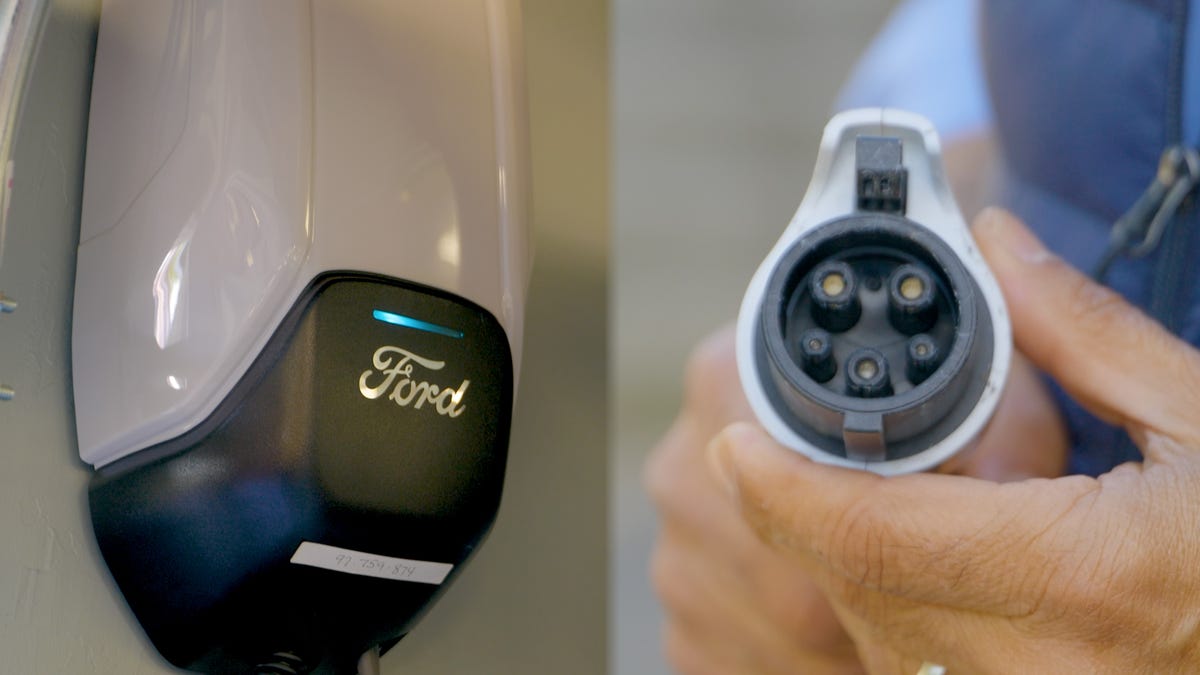
The device on the wall and its associated cord and plug is technically not an EV charger, but electric vehicle supply equipment.
The purpose of EVSE is to communicate an “all clear” with the onboard charger when the car is properly connected to begin charging and then stop and start supplying AC power as needed. It’s essentially a smart relay that ensures the safety of the high-voltage connection between your car and the grid, preventing arcing, sparking or fires. Some EVSE go above and beyond, adding features and value like smart energy monitoring via Wi-Fi or Bluetooth or charge scheduling. You can learn more about that in our Best Home EV Chargers guide.
Since the onboard charger is a fixed part of your EV, it determines (and sometimes limits) how quickly your EV can charge, what level of charging is supported and more. An EV can only charge as fast as its hardware is rated, even if connected to an EVSE that is capable of faster speeds.
Kilo-what?!
In order to understand differences, advantages and disadvantages of each level of EV charging, it helps to wrap your head around the units used to describe them. Electricity coming out of an outlet is measured in volts and amps, which combine to compute kilowatts supplied by the EVSE. If you think of electricity as a garden hose, voltage is the water pressure, amps measure the size of the hose and kilowatts are the flow rate of the water into a bucket, which is your battery. Measure how much electricity flows over the course of an hour into that bucket and you’ve got kilowatt-hours, the unit that describes the capacity of your EV’s battery.
So, an EV with a 65 kWh battery connected to an 11kW home charging station will take, optimally, just under 6 hours to fully charge from flat. It’s not that simple — a variety of factors affect charging speed which rises and falls as the battery approaches full — but that’s a good starting point.
Another way of looking at and measuring charging rate is in miles per hour. Here, we’re not talking speed on the road, rather miles of range added per hour plugged in. This number is computed by multiplying your EV’s charging speed by its energy efficiency, measured in miles per kilowatt hour. So an EV that averages 3.0 mi/kWh connected to an 11kW home charging station should add around 33 miles of range per hour plugged in.
Level 1 AC charging
In North America, a Level 1 charging station or cable operates at 120 volts AC, most commonly drawn from a standard NEMA 5-15 outlet. That’s the same voltage and outlet type you probably use to charge your computer or phone at home. You may not want to plug into just any old outlet, though. At that voltage, we’re looking at pulling a maximum of around 1.4kW for charging. Make sure that outlet, and the circuit supplying it, are rated to safely maintain that wattage to reduce the risk of overloading, tripping circuit breakers or fire.
For a full EV, Level 1 is the easiest charging station type to set up, making it a great introduction to living with an electric car. But this level can also feel painfully slow. A Tesla Model Y Long Range, with its 81kWh battery, takes around 58 hours (two and a half days!) to go from flat to full. Fully charging a Chevy Bolt’s 65 kWh battery would take around 47 hours.
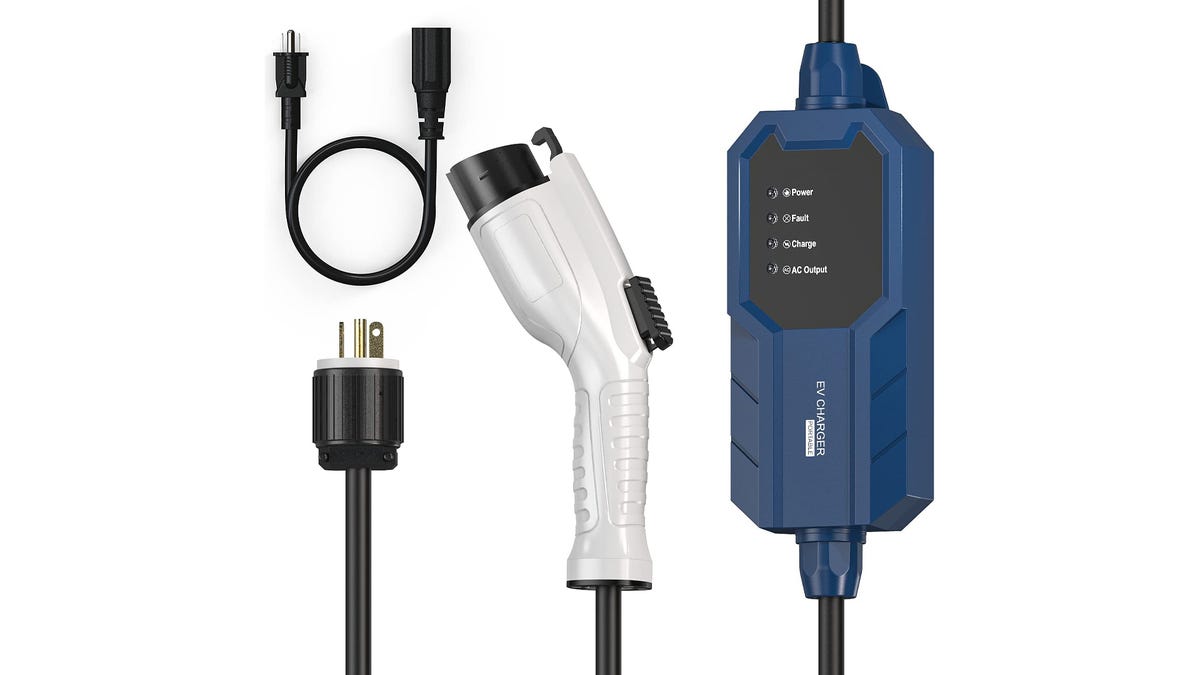
Most EVs and PHEVs come standard with a portable Level 1 charge cable to get you started. Extras like this one are relatively inexpensive.
Since most drivers don’t coast into their driveway on E, here’s another way of thinking about this: A Level 1 charger adds around 5 miles per hour connected. If you drive less than 40 miles a day, you could make a Level 1 charger work for a full battery-electric EV with regular overnight charges. The rates supplied make this level a better fit for plug-in hybrid EVs, however, which usually have smaller batteries and only around 20 to 30 miles of EV range to begin with.
Level 2 AC charging
The Level 2 charging spec includes stations from 3 to 19.2kW of power, but 6 to 11kW is most common in the US. Level 2 climbs to 240 volts AC, which you can find in homes powering electric clothes dryers or stoves. You can also find it at campsite RV hookups and in workshops powering welders and heavy equipment. You’ll probably want to have an electrician install a dedicated 240-volt outlet (such as a NEMA 14-30 or 14-50 socket) or directly connect the EVSE to your home’s power panel. This will ensure safety and avoid the inconvenience of having to unplug your dryer every time you want to charge.
An electrician can also help make sure your home’s power panel, wiring and sockets are up to code and capable of handling the 30 to 100-amp draw required by a Level 2 station. For newer homes, this may not be a problem, but older homes may require an electrical system upgrade or find themselves limited to lower amperage. (My home, for example, only has 30 amps of extra capacity without an expensive power panel overhaul, limiting me to around 6kW charging.)
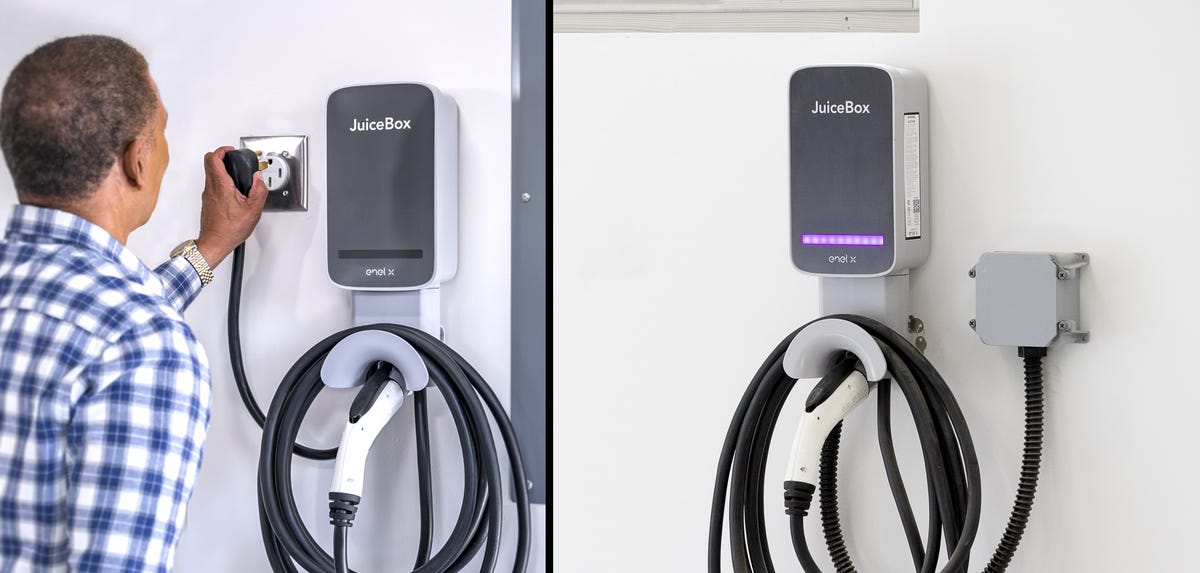
Level 2 charge adapters can be plugged into a dryer outlet or hardwired to your home’s circuitry as seen in these two examples of Enel X Juicebox installs.
Looking at our example Tesla Model Y Long Range, a 48-amp, 11kW Level 2 AC charging station will fill the battery in about 7.4 hours, adding around 39 miles of range per hour plugged in. A Chevrolet Bolt charges in under 6 hours at the same rate. This is significantly faster than the Level 1 station, making Level 2 a much better fit for drivers with long commutes, EVs that aren’t charged every day or multiple EV households that share a charging station. (Charging faster also makes it easier to fit your whole charging session into off-peak hours where electricity is cheaper, which can save you money.)
If your EV doesn’t already come with a portable Level 2 charger or you’re looking to juice up more quickly, budget anywhere from $250 to $700 for the EVSE itself. Installation can range from a few hundred bucks to over $1,000, depending on your home’s electrical system and any permits required in your area. Faster chargers tend to cost more up front and come with higher power requirements and installation costs, so balance your charging needs against your budget.
Once again, the ultimate charge rate is determined by your EV’s onboard charger. Plugging our Bolt or Model Y into an expensive 80-amp, 19.2kW station won’t add any more miles per hour than a more affordable 50-amp, 11kW setup. However, EVs with faster onboard chargers, such as a Porsche Taycan with its optional high-speed onboard charger or a Ford F-150 Lightning with the extended-range battery, may benefit from the bigger investment.
Level 3 DC fast charging
Level 3 EV charging is more commonly known as DC fast charging, and it’s a different animal from the first two levels. For starters, a Level 3 station supplies DC electricity rather than AC, bypassing the EV’s onboard charger to send power directly to the battery for the fastest possible recharge. Your EV’s charging speed limit is determined by its battery chemistry and thermal management systems.
DCFC stations also operate at much higher voltage than is usually available to residential customers (usually between 400 and 480 volts, but up to as much as 800 volts). This is why almost all DCFC installations are commercial or public stations like those on Tesla’s Supercharger network, Electrify America, EVgo or the upcoming Ionna network.
Read more: 2024 Will Be the Year We Figure Out EV Charging – CNET
DC fast charging currently ranges from 50kW up to 350kW, with most Level 3 stations averaging around 150 kW. Here again, however, your maximum charging speed will be limited by the capabilities of your car — though now it’s the battery and thermal management technology that’s the limiting factor, rather than the onboard charger.
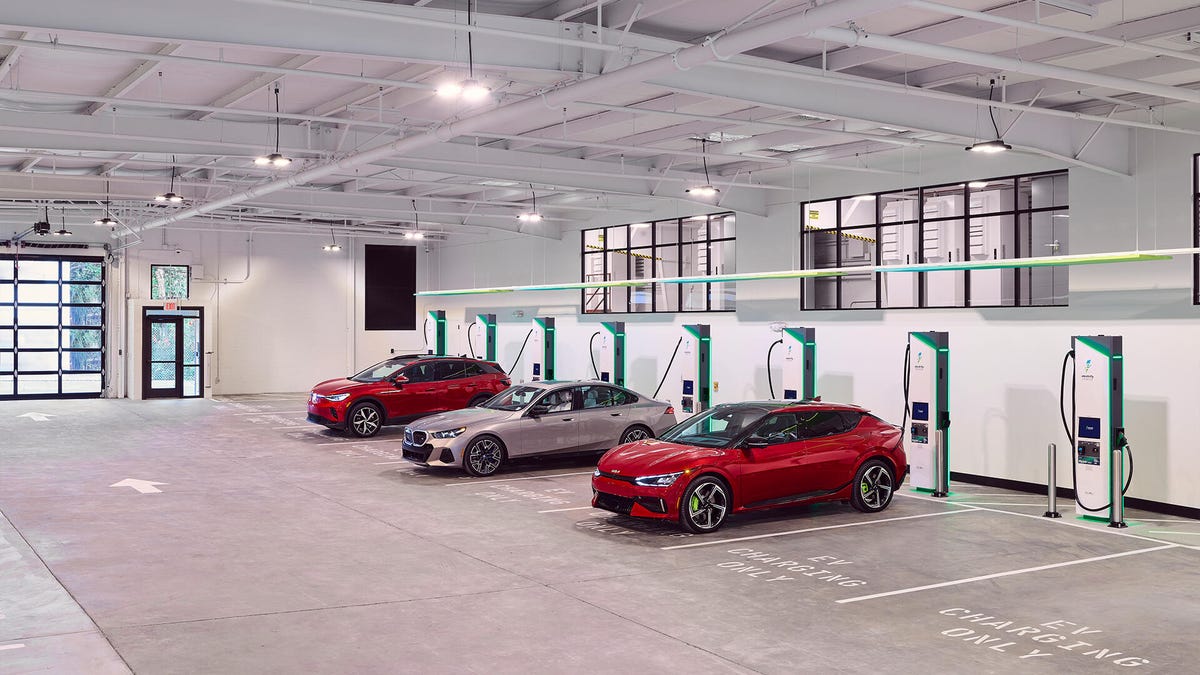
Finding a station that matches your EV’s peak DC charging rate will ensure the fastest charging possible.
Our Chevy Bolt example tops out at around 55kW and about 44 minutes for a 10% to 80% charge. There’s no speed benefit for the Bolt driver connecting to 150kW or 350 kW-capable stations versus a 50kW stall. (That said, a more powerful station won’t harm the car either.) A Tesla Model 3 LR only takes around 18 minutes for a 10% to 80% charge, despite its much bigger battery and longer range delivered by its 210kW-capable connection. So if you’re a Tesla owner, you may want to filter your charging search to avoid 50kW stations when you’re in a hurry.
NACS, CCS, ChaDeMo?! Connectors explained.
EV charging stations come with different connector types that you’ll need to match to your EV. Tesla uses the NACS connector for Levels 1 and 2 home charging and for DC fast charging at its Supercharger stations. The rest of the North American EV industry currently uses the larger J1772 connection for Level 1 and 2 and the CCS1 standard, which adds a pair of dedicated DC pins, for Level 3 DC fast charging.
Older EVs may have a ChaDeMo DC charging connection, but that standard has largely been discontinued in the US. Only the Nissan Leaf still uses it and the automaker has moved to CCS with the debut of the Ariya. However, many DC fast charging sites retain one or two vestigial ChaDeMo connections to accommodate these older EVs.
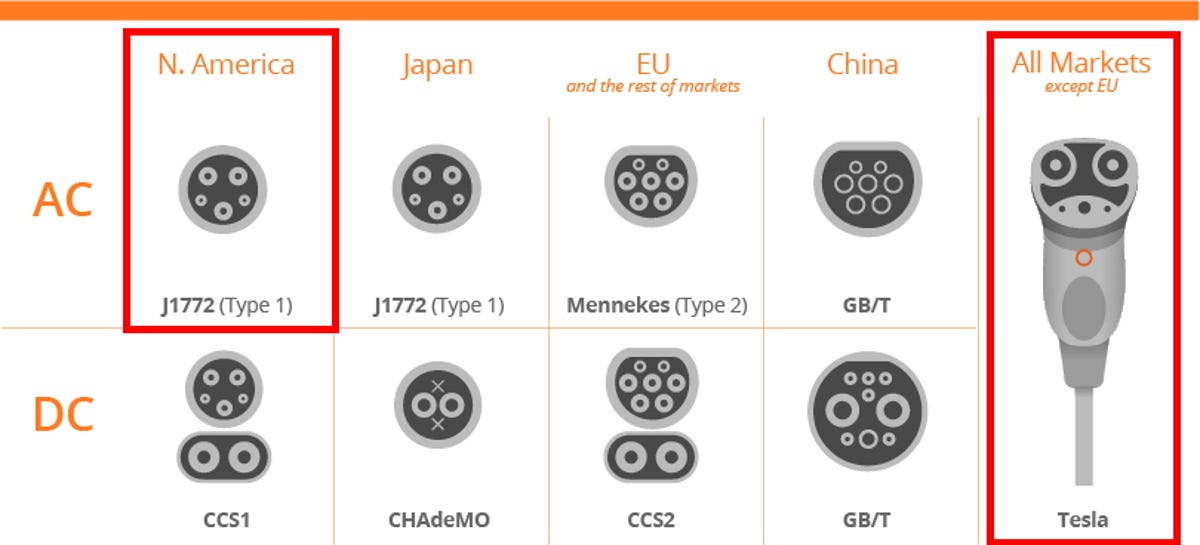
The two charge connectors highlighted are pretty much all you’ll encounter for home charging in North America.
Most automakers have recently committed to switching to the NACS standard for future generation EVs coming in 2025 and beyond. Adapters can be used to switch between J1772 and NACS fairly easily for Level 1 and Level 2 charging, which makes life easier for mixed standard households. DC fast charging CCS to NACS adapters are a bit more complicated but are also beginning to ship to interested EV owners as automakers — such as Ford with its recently revealed High Speed Charging Adapter — bring their Supercharger compatibility online.




















+ There are no comments
Add yours